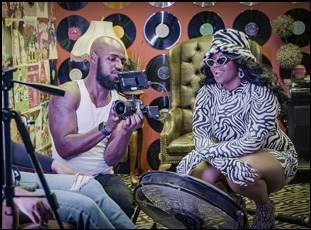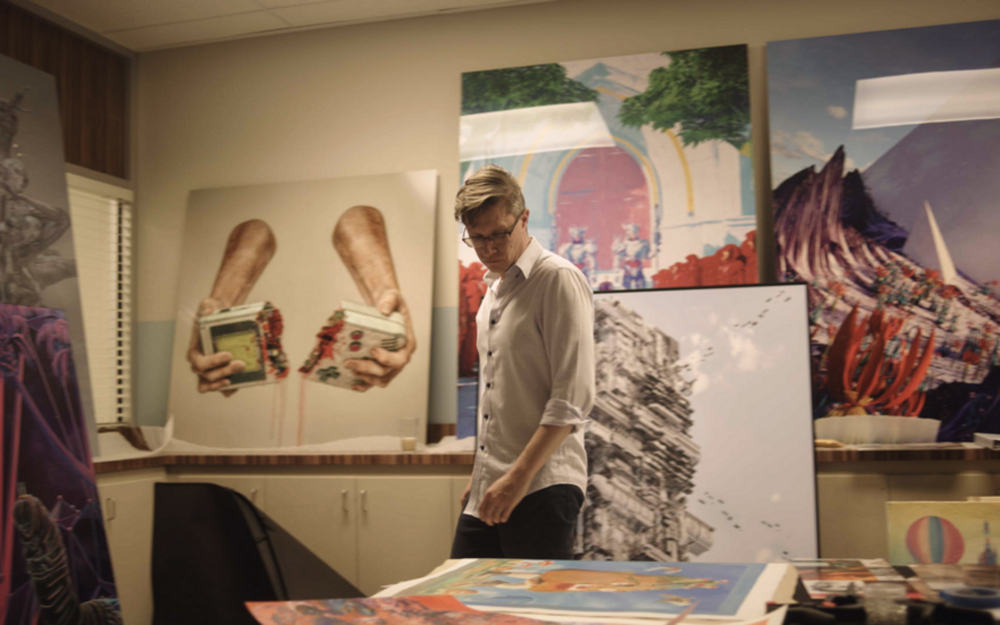After hitting the road with the late, great Ady Barkan, who dedicated his life to improving health care in America after receiving a diagnosis of ALS, for the 2021 doc “Not Going Quietly,” it could seem like a bit of a surprise that Nicholas Bruckman would turn his attention from meeting people face-to-face across the country to dipping into the shadowy virtual space of non-fungible tokens (NFTs) to look at the burgeoning market for digital art in “Minted.” Yet for the director, the path was more direct than it appears from afar.
“[Some are] a little bit confused about why I would delve into the world of crypto and NFTs after doing a film about sort of progressive activism, which are seen as different worlds,” but I think there is some overlap between the two stories,” said Bruckman, who racked up just as many frequent flyer miles if not more for his latest film than his last despite the fact that most of the action was happening online.
In fact, like “Not Going Quietly,” “Minted” tackles the issues of a money-driven system that doesn’t serve the best interests of the people that depend on it as Bruckman is around to see the market take off in dramatic fashion for digital artists that can create scarcity for their work with NFTs where the title to it is exclusive to the buyer. Opening with the landmark $69 million sale of Beeple’s “Everydays – The First 5000 Days” at a Christie’s auction in 2021, the film shows the wealth being spread around in a gold rush-type atmosphere for artists far and wide who could never make a living from their work, able to bypass the traditional gatekeepers such as galleries and art dealers that could lend credibility to them and in many cases overcome the geographical barriers to entry when the director finds artists outside of cultural centers from Nigeria, Cuba and the Netherlands.
However, even within the few years that “Minted” covers, Bruckman sees how much of it could be a bubble when the Beeple sale appears to have been motivated more by advocacy for cryptocurrency in general when bought by a Bitcoin tycoon and the buying frenzy inevitably settles down. Although the film chronicles a phenomenon from beginning to end, the director shows that the NFT craze is hardly a historical anomaly as artists have gone to great lengths before in their search for sustainability, having to get as creative as entrepreneurs as they’ve been in their general practice. Whether or not there’s quite literally any real money in it, the film ends up capturing a tangible shift in the art world where digital artists think about getting their work out to the public in a different way and those more involved on the business side such as curators and brokers begin to create more space for it in physical world.
Following a successful festival run this past year, “Minted” now carves out a place for itself with a premiere on PBS’ Independent Lens this week and Bruckman reflected on getting his arms around such a hot potato subject, how he could understand his subjects because of his personal experience and keeping a healthy mix of optimism and skepticism about what he was filming.

I’m always interested in iconoclastic characters and people trying to innovate and do new things and change the world. I’ve also always been interested in digital art. Even though I do traditional documentary films, I wasn’t in a traditional film program. I was making experimental video and music videos and learning about Nam June Paik, so I had been familiar with the [digital] artists for many years, long before NFTs became a thing. And I remember seeing in 2020 and early 2021, the incredible surge of interest and money, particularly in Beeple’s work as I was following him on Instagram. What was so fascinating to me about it is the real reason I never became a video artist is because there was no money in digital art. Museums weren’t showing it and it’s something that can be copied. Very few people made it as digital artists — even Beeple, the star of the film, had to do commercial work to get by. And suddenly there was this technology that made being a digital artist an actual viable profession, so that really called back to my earlier days exploring this technology.
Right around the same time, I met some producers who were interested in working on a film set in this crypto world and it was just a perfect marriage because I was particularly interested in the artistic applications of it. The producers were also interested in how crypto could be used to make the world better or to affect artists in a positive way, so we decided to embark on this journey showing the good, the bad and the ugly of it. That journey took us all over the world to Cuba, to Nigeria. It was really important for me to show that this story was more than just about NFTs, that this was a story about artists trying to come to terms with the society that we live in now and to set the film in the context of art history. We never could have imagined at that time what an incredible rise, crash and maybe rise again that it’s happening right now.
There really was this explosion of artists from across the world. What was it like narrowing down who you followed?
We shot almost a hundred days on the film, which is quite a high number and part of that was following many characters around the world. We really wanted to show the global scale of this movement and that this was not just one lucky guy named people selling an NFT for $69 million that this sparked this global movement with young people, older people, immigrants and people that you just wouldn’t expect to be engaging in NFTs. And in the edit room, we’d had about a dozen characters that had full arcs, but of course you want as a filmmaker to have deep connections with the characters. We didn’t want to make a film that was replete with talking heads saying how this had changed their lives, so we knew ultimately that what would tie the film together was the market force of NFTs.
We knew that people would be interested in this to see the swell and the fall of this market economy phenomenon and we followed characters that we could tie to those milestones, so we wanted to be with the characters when they were seeing their greatest success, like Justin Aversano selling his Twin Flames NFT at Christie’s Auction House, and similarly to be with those characters when they were struggling with the market, like being with Karina, the Cuban artist, after the NFT market had collapsed and knowing that she would have to ultimately leave Cuba. We selected the characters based on the ones that we were able to connect most closely to the larger market force.
Looking back on it right now, it’s clear what the arc of the film is — that there’s this dam that bursts after the pandemic when crypto markets take off and Beeple has this incredible sale that shakes the whole art world. And then that all rises to a fever pitch and then comes down to reality. That’s a very clear arc, but as we were making it, as with any good documentary, you really don’t know what’s going to happen next and to a large extent, we don’t know what’s going to happen now. We have the title as “the rise and fall (?) of NFTs,” because while many people think of this as like a Beanie Baby type fad or phenomenon, the film doesn’t make that argument. The phenomenon really changed these artists’ lives, and while of course there are malicious and nefarious elements of this world, much of the core ideas of it — of exchanging value digitally, of supporting artists through this medium of museums, and adopting digital art, — I think all of that’s here to stay, largely because of these innovative artists that pioneered and pushed this technology forward. So hopefully it’s a little bit of a deeper story than about a bubble bursting, but actually really about a movement that these artists push forward.

Yeah, there were a lot of twists and turns because at first [the market] was all only up and it was just complete euphoria for all of the artists in the film. All of the crew members wanted to make NFTs and it seemed like the world was changing rapidly. Then there were people like the experts in the film and so many other artists, even Beeple himself, who noted that we should be cautious about all of this. He was able to separate out the marketing from the reality, even as somebody who’s benefitted so much from this world, so working with these artists and seeing their art persevere and [and at the same time] keep their focus on their craft and not on this craziness going on around them was very inspiring and we tried to like kind of keep the film grounded in the reality and the perspective of the artists.
Being part of this just felt unbelievable because people were making fortunes who had never seen that kind of success before and as an artist myself, it was very easy to get swept up in that, but we wanted to make sure that we kept the film down to earth. We also wanted to show that this was not just a one-off phenomenon, but something that has precedent in other artistic movements, like Yves Klein, the [post-war] French artist who made tokens to represent his art and other conceptual artists. Even the advent of photography went through a mode where it was purely commercial and only later was [the idea] advanced that photography is actually an art form as well. We’re in the very early days of thinking about this idea of the blockchain as an artistic medium, not just a financial medium, and if you can separate that all out from the money, it’s actually a very important story that people should understand.
This must be an interesting film to put out when there are plenty of NFT skeptics and from what I understand, boosters of it may be none too pleased that it isn’t a purely promotional piece. What’s it been like getting it out there so far?
I’ve made films about healthcare and immigration and other topics that people feel strongly about, but surprisingly this has probably been the most strong reaction that I’ve gotten from a film. What I appreciate is that people who are truly evangelists for this technology and believe that it’s going to change the world exclusively for the better have taken issue with the film and said that it’s too critical or missed certain aspects of it. And then people who think this is all a scam or a pyramid scheme have come up to me and said, “Wow, I never thought of it that way. There’s actually something there to this NFT crypto blockchain world.” So I take that polarized reaction as a compliment to the film and I hope that everybody can take something away from it, that those who see this as a panacea to all the challenges that artists face or that it’s going to fix the world’s economic system can see some of the folks who’ve been hurt by it or have their expectations tempered in some ways. Conversely, people who write all this off and say, “Oh, I don’t need to know about that. That’s all bullshit,” actually see this technology is really meaningful and has really deep applications. The ability of people to connect to an artist directly with no intermediary, that’s powerful.
“Minted” will air on January 6th on Independent Lens on PBS and be available to stream via PBS thereafter.




